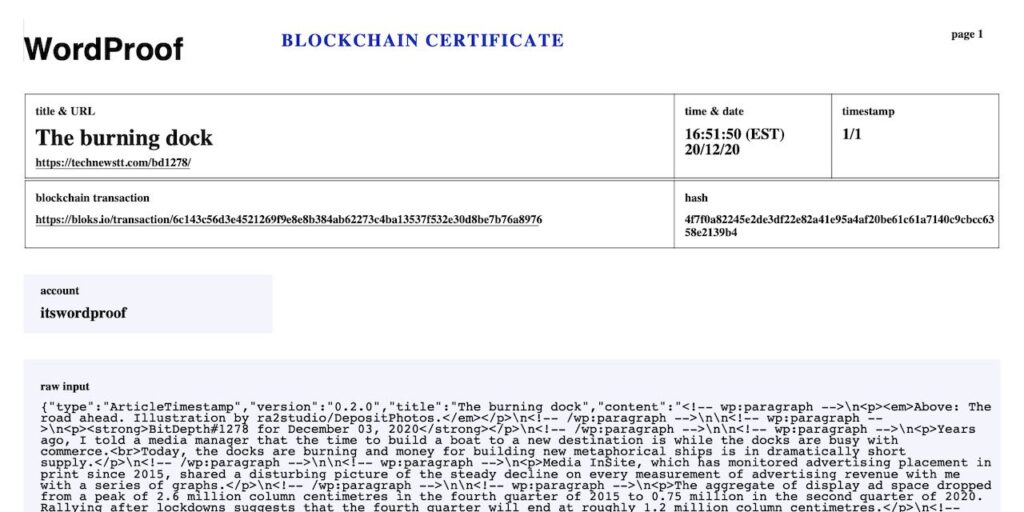
Above: The cover of INMA’s white paper on blockchain and the media.
BitDepth#1328 for November 15, 2021
Local media houses have tended to give new internet technologies the squinty eye, picking and choosing the most basic systems to maintain an online presence.
One of the most talked about new technologies, the blockchain, is also an interesting fit for news media.
‘Exploring Blockchain’s Potential to Transform Media’ by Zoltan Vardai and Jeanhee Kim is a new whitepaper from the International News Media Association (INMA).
INMA kindly granted access to the whitepaper for review purposes, and it suggests multiple engagement opportunities with a powerful technology that’s still in the earliest stages of development.
The blockchain, also known as distributed ledger technology, manages information in discrete chunks, or blocks that are strung together across interconnected computing systems.
The blocks are connected by cryptographic algorithms that make the ledger both permanent and transparent, impenetrable to change but viewable by anyone.
If one block is tampered with, other copies of it will immediately identify the discrepancy and lock the compromised block out.
It’s as if the transactions were carved into granite and put on public display with graffiti-proof paint, but it’s all digital.
The earliest use of the blockchain was in the creation and distribution of cryptocurrencies, most notably BitCoin, but newer decentralised applications are using the technology, including non-fungible tokens (NFTs) and smart contracts, which can automate agreed-on transactions.
Some central bank digital currencies, including the one issued by the Eastern Caribbean, are using blockchain ledgers.
By creating an accessible record of transactions and digital events, the system becomes trustless, because the technology immutably records changes and makes them transparent to all users.
The century-old South China Morning Post (SCMP) is tapping their accumulated reporting archive of stories, historical documents and images under the brand Artifact.
The SCMP has been continuously publishing for 118 years and Time magazine arrived in 1923.
TIMEPieces is a collection of art created by 40 different artists that TIME minted as an NFT collection.
The company is also accepting payment for memberships and subscriptions using cryptocurrency.
Time chose 20 artists and asked them to invite another artist who had never worked with the publication.
Time’s president Keith Grossman noted in the report that, “One-of-one NFTs are the equivalent of fine art.”
Most important, both publications have maintained deep archives that they can now issue as digitally authenticated versions that can be sold to buyers.
Artifact will also introduce decentralised autonomous organisations (DAOs) to elements of the paper’s governance processes as well as the management of its NFTs.
In the report, Troy Young, former global president of Hearst Magazines noted that, “The rise of DAOs foreshadows the emergence of a new type of collectivist media organisation structure, centered on creator/journalist owners and an overall flattened equity structure.”
Other efforts at using the blockchain and cryptocurrency to remodel publishing on the internet include Mirror.xyz, which uses Ethereum tokens to build and incentivise a platform that aspires to become a kind of Medium.com for readers but with clearer revenue streams for authors.
Decrypt.co which is backed by ConsenSys and reports extensively on DAOs, NFTs, blockchain and cryptocurrency, minted its own reader token.
ConsenSys was also the parent company of the failed Civil registry.
Opportunities for media to participate in blockchain solutions are only likely to grow from this point forward.
Some of the reporting on the future of this aspect of the news business online is unrealistically aspirational.
Sapien.network, a human-centered social ‘tribe,’ is described as pursuing a digital token model using Etherium that is: “Rewarding the content creators directly [to] disintermediate advertising companies that treat user data as a commodity, hence returning some of the advertising revenue to the users.”
More tools are becoming available that are practical and accessible.
At the end of 2020, I timestamped my first post on TechNewsTT into the blockchain using a tool called WordProof.

I wanted a proof-of-publication for any potential misuse of my work, but WordProof also offers readers a view into the first date of publication as well as subsequent changes and edits to the copy.
That’s an important contribution to the reader transparency I aspire to on the website.
The challenge that faces local media houses is the scattered, unconsolidated state of their most precious resource beyond the occupants of their newsrooms, the raw product of all those years of newsgathering.
What empowers news organisations like the 98-year-old Time, the New York Times and the SCMP to offer rich digital product is the curation of archived libraries representing their best work, both published and unpublished.
While the digital landscape sorts itself out, media houses would do well to rethink their cavalier attitude to their archives of primary material and engineer their legacy for this broader palette of publishing.



